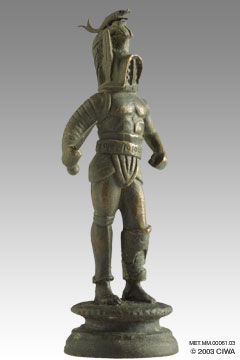
| Period: | | |
| Dating: | | 30 BC–68 AD |
| Origin: | | Roman World, |
| Material: | | Bronze |
| Physical: | | 13.3cm. (5.2 in.) - 350 g. (12.4 oz.) |
| Catalog: | | MET.MM.00061 |
Links to other views:
⇒ Larger View
⇒ Back
⇒ Torso (detail)
if scripting is off, click the ⇒ instead.
• • •
Links to others of type Statuette-man
Bacchus the child, Roman, 100 BC-200 AD
Bes in terra-cotta, Dyn. 27
Bronze athlete, Rome, 96-192 AD
Bronze Etruscan warrior, Etruria, 480 BC
Bronze Herakles, Etruria, 500 BC
Bronze Imhotep seated, Dyn. 25 (?)
Bronze ithyphallic god Bes, Ptolemaic
Bronze of a king as Nefertem, N.K.
Bronze of a king as Orisiris, Dyn. 18-19
Bronze of a king as Osiris, Dyn. 18
Bronze of a king as Osiris, Dyn. 22
Bronze of a king as Osiris, Dyn. 26
Bronze of a king as Osiris, Dyn. 26
Bronze of King Psamtik I as Osiris, Dyn. 26
Bronze of King Psamtik I as Osiris, Dyn. 26
Bronze of King Sethi I as Nefertem, Dyn. 19
Bronze of King Shabaka ? as Osiris, Dyn. 25
Bronze of Ptah, Memphis, Dyn. 25
Bronze ritual pendant of Osiris, Dyn. 25
Bronze statuette of Anhur, Dyn. 20
Bronze statuette of Ptah, Dyn. 25
Bust of Zeus, Macedonian Dynasty
Disrobing ephebe, Roman World, 50-300 AD
Enameled feathers of Amun, Dyn. 18
Gilded wooden statuette. Early Dynastic
God Bes as a Roman soldier 30 BC-200 AD
Head, realistic portrait in stone, Dyn 18
Horus-the-Child, 1070-774 BC
Horus-the-Child, Alexandria, 100-30 BC
Horus-the-Child, Alexandria, 304-30 BC
Horus-the-Child as a ruling king, Dyn. 18
Horus-the-Child as Amun, 776-656 BC
Horus-the-Child, Dyn.19, 1300-1200 BC
Horus-the-Child, Dyn. 25, 776-656 BC
Horus-the-Child, heir to the king, Dyn. 26
Horus-the-Child, Ptolemaic, 200-100 BC
Horus-the-Child, Ptolemaic, 304-30 BC
Horus-the-Child riding a swan, 304-31 BC
Imhotep, vizier and architect of King Djoser
Ivory head of Emperor Constantine
King Ahmose II (?) as Osiris, Dynasty 26
King Amenemope (?) as Osiris, Dyn. 21
King Amenhotep II (?) as Amun-Re, Dyn. 18
King as Horus-the-Child, Dyn. 12
King Horemheb as Amun-Re, Dyn. 18
King Nekaw II as Horus-the-child, Dyn.26
Osiris, King of the Afterlife, Dyn. 18
Osiris, King of the Afterlife, Dyn. 22
Osiris of an unknown king, Dyn. 18 (?)
Osiris-Neper, god of agriculture, Dyn. 18
Osiris-Neper, god of agriculture, Dyn. 22
Osiris-Neper, god of agriculture, Dyn. 25
Porphyry statue of Alexander The Great
Pottery child head, Phoenicia, 1000-500 BC
Pottery silenus (satyr), Greece, 350-300 BC
Priest of Hapy, temple of Aswan, Dyn. 20
Ptah-Min of Memphis, Dyn. 20
Queen as Goddess Neith seated, Dyn. 25106
Ruling king as Khonsu, Dyn. 20
Sept, local prince of Nubia, Dyn. 12-13
Statue pedestal of Osorkon II, Dyn. 22
Statuette of a privileged man, Dyn. 18
Stone bust of a scribe, Dyn. 18
Stone head of a king, Dyn. 12
Stone statue of King Thutmose III, Dyn. 18
Tall bronze Osiris, Ptolemaic Period
Unfinished stone statue, Dyn. 19
Wood statue of Amenemhat II, Dyn. 12
Wood statue of King Smenkhkare, Dyn. 18
|
|
This exquisitely detailed bronze sculpture represents a Samnite gladiator. Samnites were some of the most heavily armed of all gladiators. They typically wore a bronze helmet (galea) adorned with a high crest and plume, fitted with a visor that opened down the middle and was pierced with round holes. Their left leg—and only their left leg—was protected by a boiled-leather or metal greave (ocrea). Their right arm, knee, and ankles were protected by thick leather bands (fasciae), and they wore a massive leather belt. They wielded a sword (gladius, hence the name ‘gladiator’), and a large square shield (scutum, missing from this sculpture). After the reign of Emperor Augustus, Samnites were increasingly called hoplomachi and switched to a smaller, circular shield.
The Roman games were in great part an instrument of government propaganda. Roman citizens were invited to watch beasts and men, dressed in costumes representative of peoples defeated by Rome, slaughter each other. That spectacle comforted the public in their conviction of the superiority of the Roman people over the barbari. In this case, the barbari were the Oscan-speaking people of Samnium, who fought three long wars (343-290 BC) against the people of Rome, humiliating the Roman army in 321 BC, and who were finally conquered by the Romans in 290. Their land, today’s Campania, was absorbed into the Roman empire, and by 80 BC all remaining Samnites had been either massacred or Romanized.
Gladiators are a rare subject matter for a bronze figurine, and this one probably dates back to the beginning of the Roman Empire (30 BC-68 AD). The shape of the helmet is uncommon. The sword and the ornament on top of the helmet are modern reconstructions.
This piece, once in the Collection Peytel, may have also been published in Morter’s work on Bronze of the Classical World under number 265 (unverified).
Bibliography (for this item)
Clayton, Peter
1986 Treasures of Ancient Rome. Gallery Books, New York, NY. (
150)
|